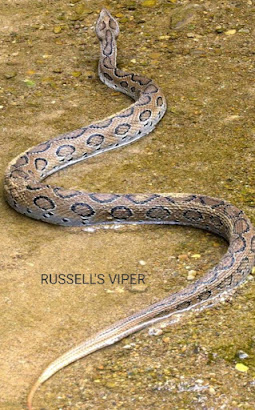Snakes of jammu and kashmir
As we know that there are more than 3300 species of snakes in this world. There are only few places and countries like Antarctica,Iceland,New Zealand, Greenland,Alaska and Siberia where species of snakes are absent because climatic conditions of these regions are not suitable for them .
India have favorable climatic conditions for the dwelling of these reptile species. There are about 260 species of snakes in India out of which 60 are venomous, causing for more than 4600 snake bite deaths in India each year . Cases of snake's bites are increasing day by day in Jammu and Kashmir
Human -snake conflicts
All snakes species are shy and like to spend most of the time out of human reaches but human- snake conflicts had increased due to the expansion of Human settlements in India. According to zoologists, Snakes usually invade Human dwellings unintentionally Or in the case of chasing the smell of rodents by using their tongue.
Ophidiophobia
It is the abnormal fear of snakes. Almost all of us are phobic to snakes (aren't u , dont lie) . First of all one important thing we should know about snakes is that only 60 species of snakes in our country are venomous. This means that other species of snakes bite you are harmless and won't do anything to you but the phobia of snake bites is so much that sometimes a victim dies of cardiac arrest, doesn't die of poison. There is so much great fear in the mind, that should not be there . Hence we need to be aware of such things.
Species of snakes in Jammu and Kashmir
Here is the description of different types of snakes found in Jammu and Kashmir.
1.RUSSELL'S VIPER
Family- VIPERIDAE
Scientific name------ DABOIA RUSSELI
Habitat -Plains, Hills, open grasses and bushy areas. But avoid human environment, Marshland, Swamp, Rainforest
Status - venomous
Bite symptoms- pain at the site of the bite, swelling, bleeding from gums and urine, signs of blood sputum, B.p and heart rate fall, renal failure, cardiac failure and death may occur 1 to 14 days after the bite.
Family - COLUBRIDAE
Scientific name - SPALEROSPHIS DIADEMA
Habitat- over trees, caves, low shrubs areas.
Status- non venomous
3.COMMON KRAIT
Family - ELAPIDAE
Scientific name - BUNGARUS- CAERULEUS
Habitat - field, low lying forests, near water resources , even invade human settlements during raining seasons to find dry places.
Status - Venomous
Bite symptoms - bite feels like ant or mosquito bite, minimal amount of inflammation around the bitten area, inability to talk and blindness, face paralysis, death with in 4-5 hours from respiratory paralysis if left untreated.
4.BLACK COBRA
Family - - ELAPIDAE
Scientific name - NAJA- MELANDEUCA
Habitat- moist Sahvanna, Lowland forest, semi aquatic regions.
Status- venomous
Bite symptoms - cardiovascular and central nervous symptoms defects
5.SPECTACLED COBRA
Family- ElAPIDAE
Scientific name- NAJA - NAJA
Habitat- Dense forest,plains ,agricultural land,rocky terrain,urban wetlands and even in heavily populated urban areas,villages,city atmosphere and from sea level to 6600 ft in altitude.
Symptoms- neuro-toxic activity and cardiovascular problems, paralysis muscles
6.COMMON WOLF SNAKE
Family -COLUBRIDAE
Scientific name -LYCODON CAPUCINUS
Habitat - limestone hills, concrete, walking porches.
Status- Non-venomous
7.CHECKERED KEELBACK SNAKE
Family-COLUBRIDAE
Scientific name -XENOCHROPHIS
PISCATOR
Habitat- Drains, freshwater lakes, River and water sources
Status- Non-venomous
Family-PYTHONIDAE
Scientific name- PHYTHON MOLUSUS
Habitat- Grassland, swamps , marshes, rocky foothills, forest and river Valley, area with permanent sources of water.
Status - Non venomous but still can kill humans with it large size by using mascular contraction
Family- VIPERIDAE
Scientific name - MACROVIPERA-LEBATINUS
Habitat- short trees, shrubs and herbs with Thick shade particularly in mountains and hills
Status- Venomous
Bite symptoms- pain, rapid swelling, breathing problem, unknown taste in the mouth, tingling in the various part, change in heart rate , dizziness and Nausea
Family- VIPERIDAE
Scientific name- GLOYDIUS HIMALAYAN
Habitat- High-hills, mountains, rocky places, crevices, fallen leaves, Bigstone cracks
Status -Venomous
Bite symptoms- intense local pain, swelling within 2 to 3 days
Family- COLUBRIDAE
Scientific name- ZEMENIS LOGISSIMISIS
Habitat- Forest surrounded by grasslands
Status- Non-venomous
12.INDIAN CAT SNAKE
Family-COLUBRIDAE
Scientific name - Boiga Trigonata
Habitat -varies from higher hill to plain areas
Status - Mild venomous thats not dangerous to human
Family- BOIDAE
Scientific name- ERYX-JOHNII
Habitat- dry, semi-desert, plain areas, rocky dry foothill, loose soil and live underground.
Status- Non-venomous
Scientific name - COELOGNATHUS LETENUS
Habitat- Lowland areas, old trees, brick mounds, old houses, medium to dense vegetation.
Status -Non-venomous
All these snakes are not venomous but due lack of awareness many people underestimate bite, causing their death. Now many antivenom medicines and serums are developed to decrease mortality rate cause by snake's fatal bites. In Hindu as well as in Dogra culture these creatures are worshipped as Gods and are part of religious stories.














Comments